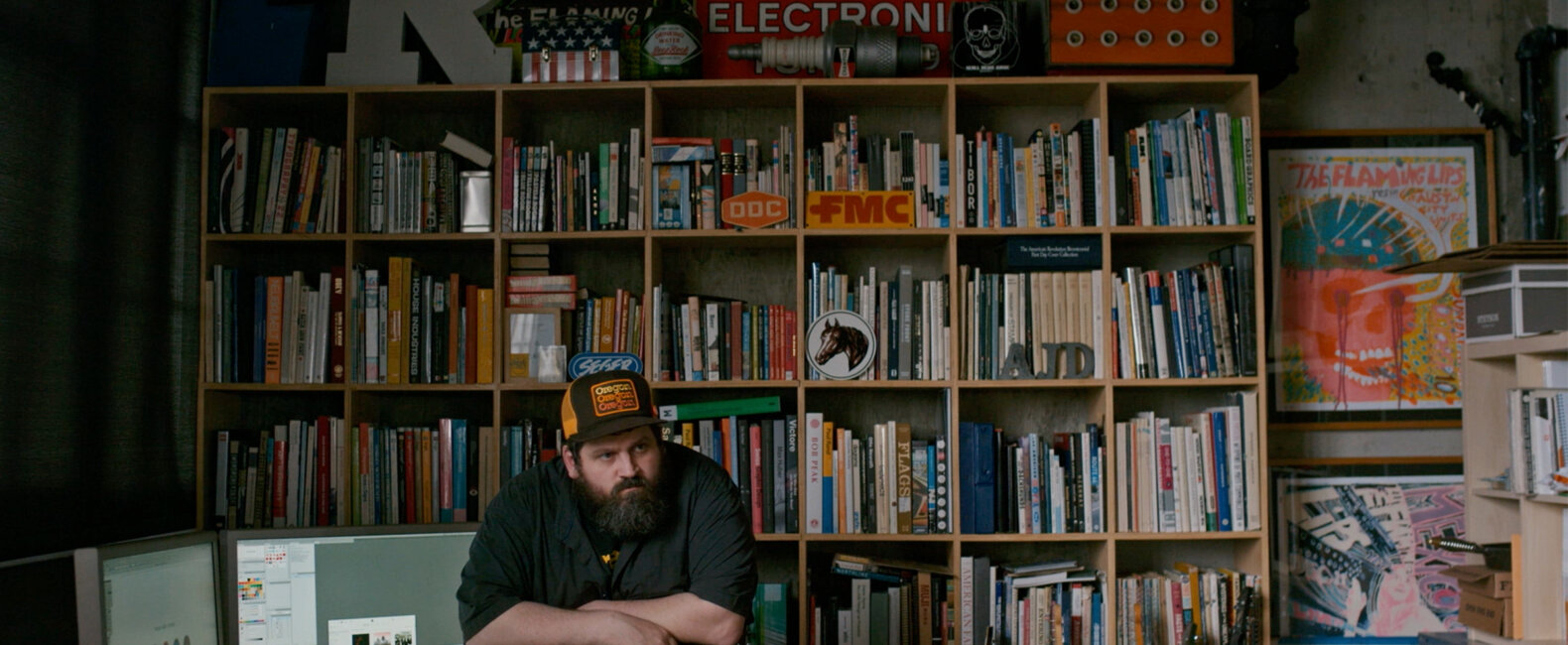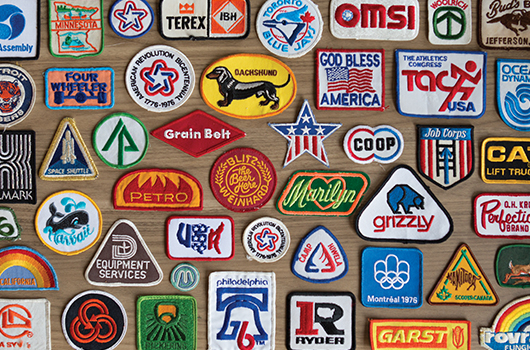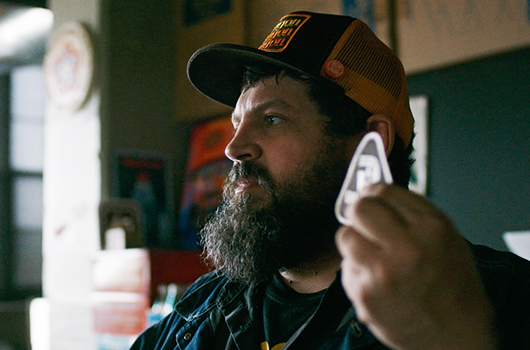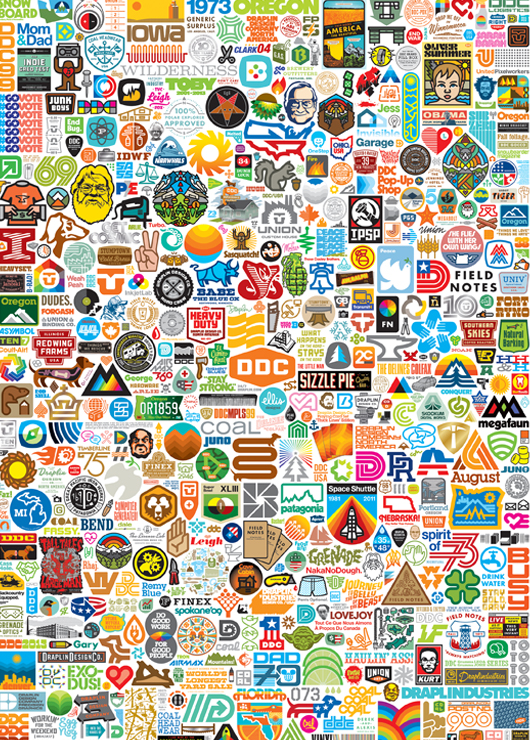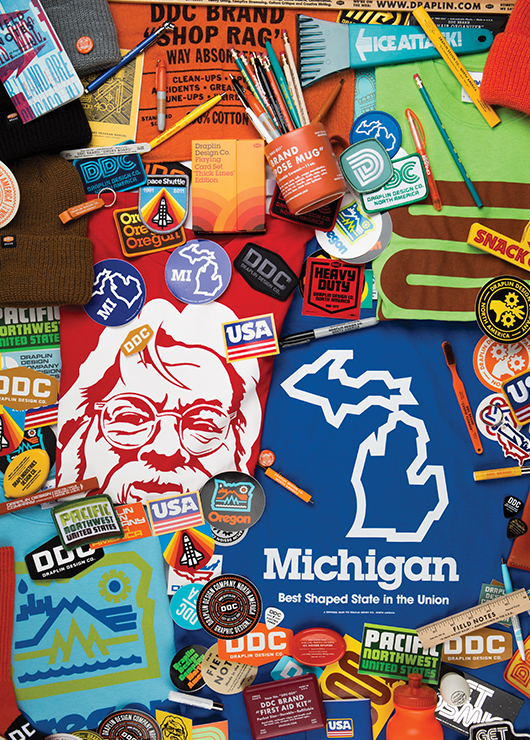“An important attribute of a great junk shop is longevity,” Luc Sante wrote recently in The Paris Review. “It should accrue layers, like an archeological site.” By this definition, you could consider famed graphic designer, ephemera enthusiast, and second-generation junker Aaron Draplin an archeologist. Inside Draplin Design Co., Aaron keeps an ever-growing collection of artifacts he’s found and swiped for just a dollar or two from junk stores and bargain bins around the world. “See, when you find old, shitty Chevron stickers all stuck together like this, you don’t ask for just one,” Aaron told us. “You ask for the whole stack because then you can trade them with your buddies.” Later, he described himself as a rescue unit. He’s saving bric-a-brac from oblivion and using it to fuel a fresh round of timeless, creative work.
Bric-a-brac, n.
/ˈbrikəˌbrak/
miscellaneous objects and ornaments of little value. synonyms: ornaments, knickknacks, trinkets, bibelots, gewgaws, gimcracks
From Sante’s point of view, a good junk shop isn’t an antique store; it doesn’t exist to make money. Sometimes the least valuable items, at least in a monetary sense, are put on the front shelves. In a way, this is the exactly how Draplin operates. Money is often the furthest thing from his mind. “If the work is done well,” he told us, “that transcends how much you got paid for it.”
We recently interviewed Aaron for our documentary, MAKE. But what we left behind in the transcript was too good to throw away. So in the junking spirit, we’ve rescued the bits below from our own trash can. Spend a few minutes with the incomparable Aaron Draplin.

MB: What led you to find inspiration in junk shops?
My dad. Oh my god! I wish you could have met my dad. He’s so dead. He’s about as dead as it gets, and we’re saving a ton on groceries; but he would have eaten you alive. Jim Draplin was one of the greatest human beings ever. I mean it! Ever! He died a year and a half ago. (I’m not counting or anything.) He was a master Polish citizen, a champion of Detroit, and a junker with a love for weird little things. We were raised in an old farmhouse that my dad gutted and redid, so we always had this appreciation for old, dead things.
My dad had walls filled with bric-a-brac. One time he called me and said, “Aaron, I was digging in the garage and guess what I found?” I said, “What, Dad?” He said, “I found a wall!” [Laughing] So that’s who made me this mess. He loved the tactile quality of things. And it’s just so weird to talk about him like he’s gone because he’s not gone! He was too big to be gone all of a sudden. I’m not ready for him to go. You pick your superstitions — and there’s no shortage of superstitions in this world, so I’ve made up my own: I’m going to see my dad again on some astral plane, and we’re going to junk the cosmos together.

How do you turn junk shop inspiration into creative work?
Well, look at this cool stuff, man! It’s like, “Whoo! A four-wheeler!” There’s so much charm here. We used to make a patch with just an axle and four wheels. Why don’t we do that anymore? Everything is so smart or ironic. But when I see things like this patch, I’m reminded that things can be simple and dumb. We need that reminder. So for me, I go junk for an afternoon and see all this stuff ⎯ like, I paid a quarter for this, but it’s worth thousands of dollars to me because it reminds me that you can have a dumb T-shirt and it’s the coolest thing going, you know? That’s very liberating to me in a world where everyone is on top of each other and looking at everybody’s stuff all the time. But look, here’s a shoebox that was made in Poland. Here’s a polar bear. It’s real stuff, and I have to remind myself to get back in there and play with it.
Are those simple old designs better than designs now?
Yeah, they’re better. There used to be a lot of limitations. You had one or two colors. Your design had to work with embroidery. But, for example, the logo design for the city of Dallas is so good, it’s still being used on some cleaning guy’s uniform right now. It worked in 1982 and it still works now. Think about what we can do now — these websites that can fold and flap and buzz and ding. But we don’t need those things. We can make something simple and it will still work. There is a beauty to working within limitations. If someone can work within a budget and be effective and not waste a bunch of money — something about that is really beautiful to me.
Go into Office Depot and find a package of Avery thumbtacks. That’s still Saul Bass’s work in the corner. Look it up. He did that logo 30 or 40 years ago. That’s the power of this stuff. It wasn’t about being clever or ironic. It was about making something that worked. You see all these fancy tips and tricks about things. But spend one afternoon looking at stuff like this, and you’ll be reminded of what is beautiful. This work was purely functional, and it was a great thing.

There is a beauty to working within limitations. If someone can work within a budget and be effective and not waste a bunch of money — something about that is really beautiful to me.
Do you try to be innovative in your work?
Well, I don’t know. The funny thing is I get hired for jobs and people will say to me, “Your logos look different to us.” They don’t know how to articulate it in the nerdy ways that I do, but they like the ubiquity and simplicity of the form. It’s refreshing to them. Which is funny because it’s like these designs are just coming back around. A lot of this shit is very, very cyclical. It feels new to a lot of people, and honestly that’s just because they don’t know their history. More than being innovative, I’ve always reacted to what was around me.
Back when I started making logos in 1995, there was all this scritchity-scratchity post-modern bullshit going on. It was garbage. I tried my hand at it for a while, but it felt so phony to me. It felt like art for art’s sake. You couldn’t read these things. You could see them. You couldn’t embroider them. So I reacted against that and started looking into the grid, the simplest most basic forms of design systems. And that’s where I had my mind blown. It was so refreshing to me, and it still is today.
What’s the difference between doing small work for your friends and big work for brands?
You don’t get any money for the small shit. That’s one big difference. And what’s the goal of any of this? It’s to make a living. But then you get a little cocky because you’re like, Damn! I can make a living! You can take care of people. I paid off my house and my Volvo, and I got an appendectomy. I’m an appendectomy survivor. But I guess the thing is, even when I’m doing something for no money, it’s not like I put in any less effort. I’ll kill myself making either one.
Sometimes kids come up to me and say, “Hey, how do I get to do what you do?” But you have to be careful about thinking you can get on a path where you get to do whatever you want. That’s not how the world works. Even I don’t get to do that. I’m still on the clock. Sometimes the best path for someone is to have a good job and leave at five o’clock every day. I love hearing from my buddies who leave at five and go home to their families and have all these things going on outside of their jobs. Because me, I work until midnight. So I always tell kids that if you want to do what I do, it’s not just a job. It’s your life. And the trick is to do a good job, take it on the chin, save your money, pay off your shit, and try to get free. But most of all ⎯ do a good job!
I want to be careful not to slam anything, but we’re in this time period when everything is starting to look the same. Someone does something great and shares it on Dribbble on Monday night, and by Tuesday afternoon you’re seeing versions of it that somebody ripped off. I try to warn people and tell them to go their own way. Whatever little thing I carved out for myself was a direct reaction against what I saw around me. If I didn’t like the way logos were being made, then I found my own way to do it. And even if nobody ever looked at it, I would still be making cool shit with my buddies. Even before anyone was interested, that’s what I was doing. It was a great life.

Even if nobody ever looked at it, I would still be making cool shit with my buddies. Even before anyone was interested, that’s what I was doing. It was a great life.
How do you manage to get so much work done?
I work on the plane. I work in the hotel room. Everyone wants to go out after the gig, have a big dinner, and then drink for a couple of hours. But I don’t do that. I’m not a drinker. I always have a project bringing me back to the room, and I have to hammer it out because I promised to deliver it the next day. I just try to make really good use of my time. I don’t splurge and say, “I’m on vacation for the next six days.” I never do that because that would be six days when I could be getting something awesome done. Sometimes I take stock of all the time I haven’t spent camping. It makes me think, God, I’ve spent a lot of time making logos. But I’m proud of it. And I have a lot of stuff to show for it.















































































